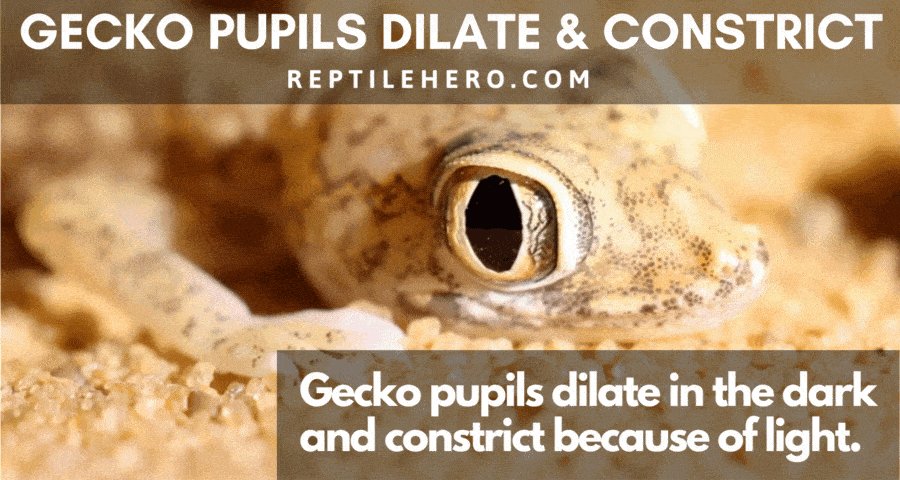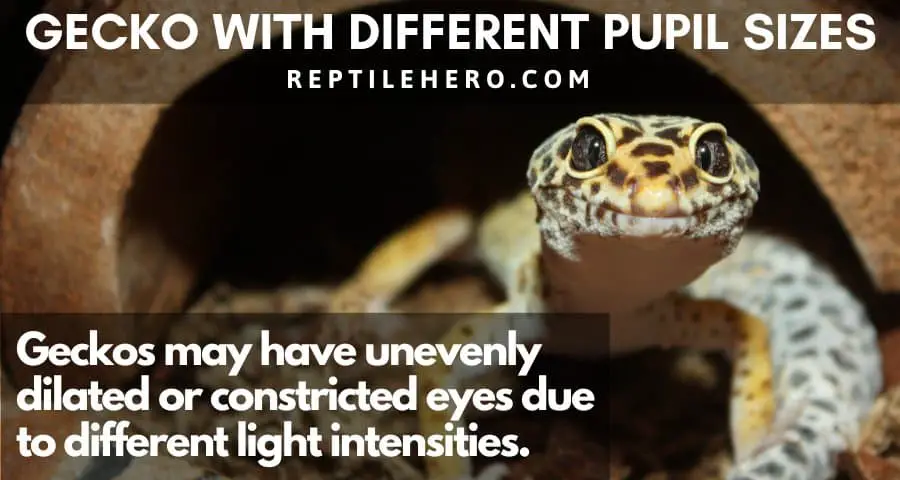Why Do Your Leopard Gecko’s Eyes Dilate? (Is It Normal?)
As the old saying goes, there’s more than meets the eye. For our cute leopard geckos, this is definitely true—especially once you can see their gorgeous eyes up close! But why exactly do their pupils dilate? Is it a normal thing? Or could it be a sign of a problem? Let’s find out!
Leopard gecko pupils normally dilate when the light gets less intense. Conversely, gecko pupils constrict more as the light gets brighter. Because they have their eyes on either side of their heads it is normal for their pupils to be unevenly dilated or constricted at times.
For humans and many other animals, pupil dilation and constriction happens automatically and evenly. So is it the same for leopard geckos? Or can they control it? Continue reading to learn the answers to these questions and more!
Lighting: The Reason Why Leopard Gecko Pupils Dilate
The pupils of leopard geckos dilate in response to low light and dark environments. By doing so, they can continue navigating their environment and hunting for prey with very little light. Dilated pupils of geckos can appear oval or round.
When in a well-lit room, you’re likely to see that your little leo’s pupils are thin and slit-like. This is because leopard geckos are crepuscular animals that also need to be able to survive with little to no light in the wild.
In comparison, diurnal geckos such as day geckos normally have small eyes and rounder pupils even during the day [1].
As such, leopard geckos typically have black slit-like pupils when photographed during the day. Their pupils only get bigger and more round-like as the light in the room or tank they are in becomes progressively dimmer.

Because of this, our precious leopard geckos are not only able to see their prey with great detail at night. Our gecko’s special eyes also allow them to see in color even when almost no light is available.
Learn which types of lights to avoid in our article on red lights and geckos!
This is amazing considering how we have poor night vision and we only see in grays and blacks in such cases.
Excessive and prolonged exposure to intensely bright light—be it natural or artificial—can lead to photoreceptor bleaching, which can greatly ruin their vision in the long run. So having fully dilated pupils at all times can harm the eyes of leopard geckos.
Simply put, being able to constrict their eyes while exploring or foraging during the daytime protects a leo’s eyes. Pupil constriction allows nocturnal, crepuscular, and cathemeral geckos to safely navigate bright areas as well, no matter the time of day.
However, what I find most mind-boggling is that geckos are believed to be able to control the dilation and constriction of their pupils [2]. This may be traced to the fact that geckos don’t have a consensual pupillary light response—but more on this in the next section!
Why did my gecko’s pupil constrict in front of my infrared camera?
A leopard gecko’s pupils can constrict in front of an infrared camera despite being kept in an otherwise completely dark environment because of the indicator light of the unit. This light is often in front of the camera’s body, making it easily visible to geckos. Their pupils react to the light and not the infrared waves.
Is It Normal for Leopard Geckos to Have Different Pupil Sizes?
It is normal for leopard gecko eyes to have different pupil sizes because they face opposite sides and potentially experience different light intensities. Furthermore, leopard gecko pupils can react independently of each other, resulting in uneven pupil dilation and constriction.
Remember that leopard geckos have their eyes on opposite sides of their head. So if they have one eye directly facing a light source, their other eye is likely going to receive less light in comparison.
Although it’s perfectly natural for leopard geckos to have evenly dilated or constricted pupils when they are exploring in the open, it’s not weird to see them differently sized.
This is more so true when half of their heads are in the shade, with one eye directly facing the light source and the other facing the darker area opposite the light.
In other words, each eye of your leopard gecko will respond accordingly to the predominant environment. The eye left in the dark shade will stay dilated, whereas the other eye exposed to bright light will constrict!

More technically speaking, experts call this phenomenon non-consensual pupillary light [3]. Unlike in humans, gecko pupils change independently. Also, a skeletal muscle—not an optic nerve—controls how their iris moves.
Due to that, geckos can’t move their irises automatically. This could explain why a gecko’s eye will no longer respond correctly to light after an injury even when the other one still works fine. Such cases are not uncommon in cohabbed geckos.
Interested in learning more? Discover the dangers of housing geckos together!
But keep in mind that the overall appearance of a gecko’s eyes can also affect how people see their pupils dilate and constrict, which brings us to my next point!
Does Eye Trait Affect How Leopard Gecko Pupils Dilate?
Some eye traits, like eclipse, make it difficult to determine whether or not a leopard gecko’s eyes are dilated due to their color, shading, and pattern. Moreover, gecko eyes are not always identical in appearance, making them look differently sized.
Now, as you probably know already, eye color and patterns in leopard geckos are pretty diverse. So genetic differences between each morph and eye trait, and a few eye traits have two or several general forms—depending on which breeder you ask.
From all the widely recognized, I find that eclipse eyes are one of the most interesting eye traits there currently are. It may either appear as snake or solid eyes, with one leopard gecko possibly having both [4].
Besides that, eye color and pattern can also greatly affect how easily leopard gecko owners can tell whether or not their cold-bellied babies have dilated eyes.
A leopard gecko that’s a super snow, for instance, could have almost completely black eyes (iris and sclera) with red pupils. But unless you’ve looked at such a gecko’s eyes closely, it’s almost always impossible to see whether or not its pupils are dilated or constricted.
One other thing I’ve noticed over the years—after seeing a bunch of albino leopard geckos, especially red-eyed ones—is that they are rarely seen with their pupils dilated. I think that this is largely because they are already very sensitive to light as-is.
So if you’re thinking of getting an albino leo, or if you already have one, make sure to provide even more furnishing and clutter, like plants, in its tank. This will give it plenty of space to take cover under!
Thinking of giving your gecko a tank upgrade? Then, consider switching to bioactive!
Further Questions
What color are normal leopard gecko eyes?
Leopard geckos normally have a wide range of eye colors and patterns from red to black, generally matching their body color and pattern to enable them to properly camouflage. However, the color of their eyes, including their pupil, iris, and sclera, are commonly predictable based on their morph as such traits do have a genetic basis.
Is my gecko excited because his pupils are dilated?
Some keepers believe that leopard gecko pupils dilate when they are excited to eat their favorite insects. In humans, this can be attributed to dopamine and oxytocin activity. However, this has yet to be studied in leopard geckos or any other reptile, especially because research on reptile emotions has only started recently.
When does pupil dilation become a problem in geckos?
Constant dilation in leopard geckos is a common sign of blindness. In such instances, their pupils neither constrict nor dilate in response to light. Abnormal pupil dilation and appearance can be a sign of previous eye trauma or injury in geckos and linked to neurological problems. Exotic veterinarian visits for such cases are strongly recommended.
Summary of Why Leopard Gecko Eyes Dilate
Similar to humans and many other animals, the pupils of leopard geckos change in shape and size in response to a variety of lighting intensities and conditions. Darkness causes dilation while brightness results in constriction.
Unlike many mammals, however, geckos have pupils that work independently from each other. Though their pupils are even dilated or constricted on most occasions, having unevenly sized pupils is not necessarily abnormal or a cause for concern.
Sources
[1] https://www.researchgate.net/publication/26815751_The_pupils_and_optical_system_of_gecko_eyes

![Can You Place Your Gecko In A Hamster Ball? [Bad Idea]](https://www.reptilehero.com/wp-content/uploads/2021/01/Gecko-Hamster-Ball-cc-768x614.jpg)
![9 Woods Safe For Gecko Tanks [and 16 to Avoid]](https://www.reptilehero.com/wp-content/uploads/2021/04/Wood-Avoid-Gecko-Tank-768x614.jpg)
![Does Your Gecko Remember You? [2 Owners’ Stories and Science]](https://www.reptilehero.com/wp-content/uploads/2021/06/Does-your-gecko-remember-you-infographic-768x614.jpg)
![Why Does Your Gecko Have Red Eyes? [6 Reasons]](https://www.reptilehero.com/wp-content/uploads/2021/03/Why-gecko-red-eyes-reasons-768x614.jpg)

![Human Foods Geckos Can And Can’t Eat [Massive List Ahead]](https://www.reptilehero.com/wp-content/uploads/2022/06/food-geckos-can-and-cant-eat-cc-768x614.jpg)
